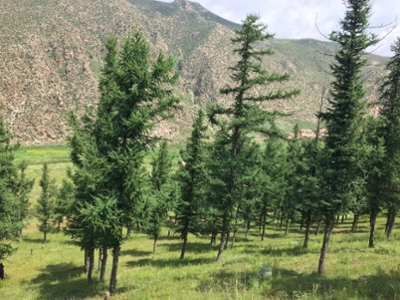High risk of growth cessation of planted larch under extreme drought.
Author: Zhang X., Li X., Manzanedo R.D., D'Orangeville L., Lv P., Wang C., Xu C., Hou M., Huang X., Rademacher T.
Posted on Mar 10, 2021
Category: Research , Publications
Abstract: Larch trees are widely used in afforestation and timber plantations. Yet, little is known on how planted larch trees cope with increasing drought. We used a tree-ring network of 818 trees from 31 plantations spanning most of the distribution of Larix principis-rupprechtii to investigate how extreme drought influences larch radial growth in northern China. We found that summer drought, rather than temperature or precipitation, had the strongest relationship with radial growth throughout the region. Drought increased in frequency in recent decades, leaving a strong imprint on the radial growth of larch, particularly in dry sites. Across its distribution, radial growth in larch trees that experienced extreme droughts more frequently displayed lower resistance to drought, but higher recovery after it, suggesting these populations were better adapted to extreme droughts. Radial growth decreased with increasing drought, with particularly severe declines below a threshold Palmer Drought Severity Index (PDSI) value of −3 to −3.5. Extreme droughts (PDSI < −4.5) caused a reduction of 62% of radial growth and chronic drought events caused around 20% reduction in total radial growth compared with mean growth on the driest sites. Given that current climate projections for northern China indicate a strong increase in the frequency and severity of extreme drought, trees in large portions of the largest afforestation project in the world, particularly those in the drier edge, are likely to experience severe growth reductions in the future
Authors: Zhang X.1, Li X.1, Manzanedo R.D.2,3, D'Orangeville L.4, Lv P.1, Wang C.1, Xu C.5, Hou M.6, Huang X.1, Rademacher T.2,7
Author affiliations:
1 College of Forestry, Hebei Agricultural University, Baoding 071001, People's Republic of China
2 Harvard Forest, Harvard University, Petersham, MA 01366, United States of America
3 Biology Department, University of Washington, Seattle, WA 98195, United States of America
4 Faculty of Forestry and Environmental Management, University of New Brunswick, Fredericton, New Brunswick E3B 5A3, Canada
5 College of Landscape Architecture and Tourism, Hebei Agricultural University, Baoding 071001, People's Republic of China
6 China Meteorological Administration Training Centre, China Meteorological Administration, Beijing 100081, People's Republic of China
7 School of Informatics and Cyber Security and Center for Ecosystem Science and Society, Northern Arizona University, Flagstaff, AZ 86011, United States of America
To read the entire article go to doi: 10.1088/1748-9326/abd214

